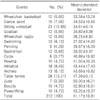|
|
| 1. |
Jung MM, Chun YS, Cho HC, Kim JK, Shin SN, Lee MY. Study of investigate the actual conditions of elite athlete's autritional state in martial events. J Korean Alliance Martial Arts 2009;11:329–339.
|
|
| 2. |
Dimeo P. In: A history of drug use in sport 1876-1976: beyond good and evil. New York: Routledge; 2007.
|
|
| 3. |
Hoberman JM. In: Testosterone dreams rejuvenation, aphrodisia, doping. Berkeley: University of California Press; 2005.
|
|
| 4. |
Hoberman JM. In: Mortal engines: the science of performance and the dehumanization of sport. New York: Maxwell Macmillan International; 1992.
|
|
| 5. |
Todd T. Anabolic steroids: the gremlins of sport. J Sport Hist 1987;14:87–107.
|
|
| 6. |
Kim JH, Chae SI, Yi HG. Doping and anti-doping. Korean Soc Sport Anthropol 2013;8:41–55.
|
|
| 7. |
Lee SH, Kim DK. The changes of doping and justification of anti-doping. Korean Philos Soc Sport Dance 2011;19:15–32.
|
|
| 8. |
Park KY, Kim HC, Lee SA, Kim JY, Moon CH, Kim SJ. Intake type of nutrient and consciousness about doping of represent athletes who attend Beijing Paralympic. J Rehabil Res 2008;12:55–69.
|
|
| 9. |
Petroczi A. Attitudes and doping: a structural equation analysis of the relationship between athletes' attitudes, sport orientation and doping behaviou. Subst Abuse Treat Prev Policy 2007;2:34.
|
|
| 10. |
Van de Vliet P. Antidoping in paralympic sport. Clin J Sport Med 2012;22:21–25.
|
|
| 11. |
Korea Anti-doping Agency. 2008 Anti-doping guide. Seoul: Ministry of Culture, Sports and Tourism; 2008.
|
|
| 12. |
Korea Anti-doping Agency. 2013 Anti-doping guide. Seoul: Ministry of Culture, Sports and Tourism; 2013.
|
|
| 13. |
Silber ML. Scientific facts behind creatine monohydrate as sport nutrition supplement. J Sports Med Phys Fitness 1999;39:179–188.
|
|
| 14. |
Cardoso EM, Stal P, Hagen K, et al. HFE mutations in patients with hereditary haemochromatosis in Sweden. J Intern Med 1998;243:203–208.
|
|
| 15. |
Malm C, Svensson M, Sjoberg B, Ekblom B, Sjodin B. Supplementation with ubiquinone-10 causes cellular damage during intense exercise. Acta Physiol Scand 1996;157:511–512.
|
|
| 16. |
Morente-Sanchez J, Zabala M. Doping in sport: a review of elite athletes' attitudes, beliefs, and knowledge. Sports Med 2013;43:395–411.
|
|
| 17. |
Barkoukis V, Lazuras L, Tsorbatzoudis H. Beliefs about the causes of success in sports and susceptibility for doping use in adolescent athletes. J Sports Sci 2014;32:212–219.
|
|
| 18. |
Dunn M, White V. The epidemiology of anabolic-androgenic steroid use among Australian secondary school students. J Sci Med Sport 2011;14:10–14.
|
|
| 19. |
Kim TG, Kim EK. Attitudes and dispositions toward doping in adolescent elite athletes. Korean J Sports Med 2013;31:99–106.
|
|
| 20. |
National team's swimmer Park Tae-hwan proved positive doping, the doping was caused that he had a injection from chiropractic. Sports donga [Internet]. 2015 Jan 27; [cited 2015 Nov 16].
|
|
| 21. |
International Olympic Committee. Anti-doping rules applicable to the games of the XXIX Olympiad, Beijing 2008 [Internet]. Lausanne: International Olympic Committee; [cited 2015 Nov 16].
|
|
| 22. |
Kim JG, Kim DJ, Song JH, Park JW, Chun YS, Kang SK. Nutritional supplements and doping consciousness in Korea International Judo Team. Korean J Physic Educ 2004;43:545–552.
|
|
| 23. |
Moran A, Guerin S, Kirby K, MacIntyre T. The development and validation of a doping attitudes and behaviour scale. Research report to World Anti-Doping Agency and The Irish Sports Council [Internet]. Ireland: UCD School of Psychology; 2008 May 16; [cited 2015 Nov 16].
|
|
| 24. |
Alaranta A, Alaranta H, Holmila J, Palmu P, Pietila K, Helenius I. Self-reported attitudes of elite athletes towards doping: differences between type of sport. Int J Sports Med 2006;27:842–846.
|
|
| 25. |
Peretti-Watel P, Guagliardo V, Verger P, Mignon P, Pruvost J, Obadia Y. Attitudes toward doping and recreational drug use among French elite student-athletes. Sociol Sport J 2004;21:1–17.
|
|
| 26. |
Waldron JJ, Krane V. Whatever it takes: health compromising behaviors in female athletes. Quest 2005;57:315–329.
|
|
| 27. |
Erdman KA, Fung TS, Doyle-Baker PK, Verhoef MJ, Reimer RA. Dietary supplementation of high-performance Canadian athletes by age and gender. Clin J Sport Med 2007;17:458–464.
|
|
| 28. |
Sundgot-Borgen J, Berglund B, Torstveit MK. Nutritional supplements in Norwegian elite athletes: impact of international ranking and advisors. Scand J Med Sci Sports 2003;13:138–144.
|
|
| 29. |
Petroczi A. Measuring attitude toward doping: further evidence for the psychometric properties of the Performance Enhancement Attitude Scale; Proceedings of the 14th Congress of the European Association for Sport Management; 2006 Sep 6-9; Nicosia, Cyprus.
|
|
| 30. |
Rimmer JH, Yamaki K. Obesity and intellectual disability. Ment Retard Dev Disabil Res Rev 2006;12:22–27.
|
|




 ePub
ePub Citation
Citation Print
Print







